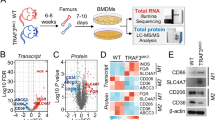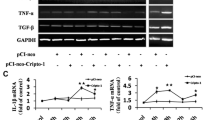Abstract
BRCA-1 is a nuclear protein involved in DNA repair, transcriptional regulation, and cell cycle control. Its involvement in other cellular processes has been described. Here, we aimed to investigate the role of BRCA-1 in macrophages M(LPS), M(IL-4), and tumor cell-induced differentiation. We used siRNAs to knockdown BRCA-1 in RAW 264.7 macrophages exposed to LPS, IL-4, and C6 glioma cells conditioned medium (CMC6), and evaluated macrophage differentiation markers and functional phagocytic activity as well as DNA damage and cell survival in the presence and absence of BRCA-1. LPS and CMC6, but not by IL-4, increased DNA damage in macrophages, and this effect was more pronounced in BRCA-1-depleted cells, including M(IL-4). BRCA-1 depletion impaired expression of pro-inflammatory cytokines, TNF-α and IL-6, and reduced the phagocytic activity of macrophages in response to LPS. In CMC6-induced differentiation, BRCA-1 knockdown inhibited TNF-α and IL-6 expression which was accompanied by upregulation of the anti-inflammatory markers IL-10 and TGF-β and reduced phagocytosis. In contrast, M(IL-4) phenotype was not affected by BRCA-1 status. Molecular docking predicted that the conserved BRCA-1 domain BRCT can interact with the p65 subunit of NF-κB. Immunofluorescence assays showed that BRCA-1 and p65 co-localize in the nucleus of LPS-treated macrophages and reporter gene assay showed that depletion of BRCA-1 decreased LPS and CMC6-induced NF-κB transactivation. IL-4 had no effect upon NF-κB. Taken together, our findings suggest a role of BRCA-1 in macrophage differentiation and phagocytosis induced by LPS and tumor cells secretoma, but not IL-4, in a mechanism associated with inhibition of NF-κB.



Similar content being viewed by others
Abbreviations
- BRCA-1:
-
Breast cancer-1 protein
- CMC6:
-
Conditioned medium from C6 cells
- LPS:
-
Lipopolysaccharide from E. coli
- IL-4:
-
Interleukin-4
References
Brüne B, Dehne N, Grossmann N et al (2013) Redox control of inflammation in macrophages. Antioxid Redox Signal 19(6):595–637. https://doi.org/10.1089/ars.2012.4785
Schebesch C, Kodelja V, Müller C et al (1997) Alternatively activated macrophages actively inhibit proliferation of peripheral blood lymphocytes and CD4 + T cells in vitro. Immunology 92(4):478–486
Gordon S, Martinez FO (2010) Alternative activation of macrophages: mechanism and functions. Immunity 32(5):593–604. https://doi.org/10.1016/j.immuni.2010.05.007
Gordon S (2003) Alternative activation of macrophages. Nat Rev Immunol 3(1):23–35. https://doi.org/10.1038/nri978
Bonder CS, Dickensheets HL, Finlay-Jones JJ, Donnelly RP, Hart PH (1998) Involvement of the IL-2 receptor gamma-chain (gammac) in the control by IL-4 of human monocyte and macrophage proinflammatory mediator production. J Immunol 160(8):4048–4056
Cheung DL, Hart PH, Vitti GF, Whitty GA, Hamilton JA (1990) Contrasting effects of interferon-gamma and interleukin-4 on the interleukin-6 activity of stimulated human monocytes. Immunology 71(1):70–75
Yang C, He L, He P et al (2015) Increased drug resistance in breast cancer by tumor-associated macrophages through IL-10/STAT3/bcl-2 signaling pathway. Med Oncol 32(2):352. https://doi.org/10.1007/s12032-014-0352-6
Maeda H, Shiraishi A (1996) TGF-beta contributes to the shift toward Th2-type responses through direct and IL-10-mediated pathways in tumor-bearing mice. J Immunol 156(1):73–78
Chahlavi A, Rayman P, Richmond AL et al (2005) Glioblastomas induce T-lymphocyte death by two distinct pathways involving gangliosides and CD70. Cancer Res 65(12):5428–5438. https://doi.org/10.1158/0008-5472.CAN-04-4395
Ueda R, Fujita M, Zhu X et al (2009) Systemic inhibition of transforming growth factor-β in glioma-bearing mice improves the therapeutic efficacy of glioma-associated antigen peptide vaccines. Clin Cancer Res 15(21):6551–6559. https://doi.org/10.1158/1078-0432.CCR-09-1067
Zou JP, Morford LA, Chougnet C et al (1999) Human glioma-induced immunosuppression involves soluble factor(s) that alters monocyte cytokine profile and surface markers. J Immunol. 162(8):4882–4892
Mehling M, Simon P, Mittelbronn M et al (2007) WHO grade associated downregulation of MHC class I antigen-processing machinery components in human astrocytomas: does it reflect a potential immune escape mechanism? Acta Neuropathol 114(2):111–119. https://doi.org/10.1007/s00401-007-0231-8
Standiford TJ, Kuick R, Bhan U, Chen J, Newstead M, Keshamouni VG (2011) TGF-β-induced IRAK-M expression in tumor-associated macrophages regulates lung tumor growth. Oncogene 30(21):2475–2484. https://doi.org/10.1038/onc.2010.619
Siveen KS, Kuttan G (2009) Role of macrophages in tumour progression. Immunol Lett 123(2):97–102. https://doi.org/10.1016/j.imlet.2009.02.011
Movahedi K, Laoui D, Gysemans C et al (2010) Different tumor microenvironments contain functionally distinct subsets of macrophages derived from Ly6C(high) monocytes. Cancer Res 70(14):5728–5739. https://doi.org/10.1158/0008-5472.CAN-09-4672
Liu CY, Xu JY, Shi XY et al (2013) M2-polarized tumor-associated macrophages promoted epithelial-mesenchymal transition in pancreatic cancer cells, partially through TLR4/IL-10 signaling pathway. Lab Invest 93(7):844–854. https://doi.org/10.1038/labinvest.2013.69
Huen MSY, Sy SMH, Chen J (2010) BRCA1 and its toolbox for the maintenance of genome integrity. Nat Rev Mol Cell Biol 11(2):138–148. https://doi.org/10.1038/nrm2831
Deng CX, Scott F (2000) Role of the tumor suppressor gene Brca1 in genetic stability and mammary gland tumor formation. Oncogene 19(8):1059–1064. https://doi.org/10.1038/sj.onc.1203269
Walsh CS (2015) Two decades beyond BRCA1/2: homologous recombination, hereditary cancer risk and a target for ovarian cancer therapy? Gynecol Oncol 137(2):343–350. https://doi.org/10.1016/j.ygyno.2015.02.017
Bae I, Fan S, Meng Q et al (2004) BRCA1 induces antioxidant gene expression and resistance to oxidative stress. Cancer Res 64(21):7893–7909. https://doi.org/10.1158/0008-5472.CAN-04-1119
Teoh H, Quan A, Creighton AK et al (2013) BRCA1 gene therapy reduces systemic inflammatory response and multiple organ failure and improves survival in experimental sepsis. Gene Ther 20(1):51–61. https://doi.org/10.1038/gt.2011.214
Zielinski CC, Budinsky AC, Wagner TMU et al (2003) Defect of tumour necrosis factor-alpha (TNF-alpha) production and TNF-alpha-induced ICAM-1-expression in BRCA1 mutations carriers. Breast Cancer Res Treat 81(2):99–105. https://doi.org/10.1023/A:1025761716283
Hu Y-F, Li R (2002) JunB potentiates function of BRCA1 activation domain 1 (AD1) through a coiled-coil-mediated interaction. Genes Dev 16(12):1509–1517. https://doi.org/10.1101/gad.995502
Houvras Y, Benezra M, Zhang H, Manfredi JJ, Weber BL, Licht JD (2000) BRCA1 physically and functionally interacts with ATF1. J Biol Chem 275(46):36230–36237. https://doi.org/10.1074/jbc.M002539200
Ouchi T, Lee SW, Ouchi M, Aaronson SA, Horvath CM (2000) Collaboration of signal transducer and activator of transcription 1 (STAT1) and BRCA1 in differential regulation of IFN-gamma target genes. Proc Natl Acad Sci USA 97(10):5208–5213. https://doi.org/10.1073/pnas.080469697
Zhang H, Somasundaram K, Peng Y et al (1998) BRCA1 physically associates with p53 and stimulates its transcriptional activity. Oncogene 16(13):1713–1721. https://doi.org/10.1038/sj.onc.1201932
Volcic M, Karl S, Baumann B et al (2012) NF-κB regulates DNA double-strand break repair in conjunction with BRCA1-CtIP complexes. Nucleic Acids Res 40(1):181–195. https://doi.org/10.1093/nar/gkr687
Benezra M, Chevallier N, Morrison DJ, MacLachlan TK, El-Deiry WS, Licht JD (2003) BRCA1 augments transcription by the NF-κB transcription factor by binding to the rel domain of the p65/RelA subunit. J Biol Chem 278(29):26333–26341. https://doi.org/10.1074/jbc.M303076200
Chang C-P, Su Y-C, Hu C-W, Lei H-Y (2013) TLR2-dependent selective autophagy regulates NF-κB lysosomal degradation in hepatoma-derived M2 macrophage differentiation. Cell Death Differ 20(3):515–523. https://doi.org/10.1038/cdd.2012.146
He G, Karin M (2010) NF-κB and STAT3—key players in liver inflammation and cancer. Nat Publ Gr 21(1):159–168. https://doi.org/10.1038/cr.2010.183
Zanotto-Filho A, Braganhol E, Schröder R et al (2011) NFκB inhibitors induce cell death in glioblastomas. Biochem Pharmacol 81(3):412–424. https://doi.org/10.1016/j.bcp.2010.10.014
Biswas SK, Lewis CE (2010) NF-κB as a central regulator of macrophage function in tumors. J Leukoc Biol 88(5):877–884. https://doi.org/10.1189/jlb.0310153
Mancino A, Lawrence T (2010) Nuclear factor-kappaB and tumor-associated macrophages. Clin Cancer Res 16(3):784–789. https://doi.org/10.1158/1078-0432.CCR-09-1015
Zanin RF, Braganhol E, Bergamin LS et al (2012) Differential macrophage activation alters the expression profile of NTPDase and ecto-5’-nucleotidase. PLoS ONE 7(2):e31205. https://doi.org/10.1371/journal.pone.0031205
Bloch O, Crane CA, Kaur R, Safaee M, Rutkowski MJ, Parsa AT (2013) Gliomas promote immunosuppression through induction of B7-H1 expression in tumor-associated macrophages. Clin Cancer Res 19(12):3165–3175. https://doi.org/10.1158/1078-0432.CCR-12-3314
Zhou W, Ke SQ, Huang Z et al (2015) Periostin secreted by glioblastoma stem cells recruits M2 tumour-associated macrophages and promotes malignant growth. Nat Cell Biol 17(2):170–182. https://doi.org/10.1038/ncb3090
Vichai V, Kirtikara K (2006) Sulforhodamine B colorimetric assay for cytotoxicity screening. Nat Protoc 1(3):1112–1116. https://doi.org/10.1038/nprot.2006.179
Somensi N, Brum PO, de Miranda Ramos V et al (2017) Extracellular HSP70 activates ERK1/2, NF-kB and Pro-inflammatory gene transcription through binding with RAGE in A549 human lung cancer cells. Cell Physiol Biochem 55(51):2507–2522. https://doi.org/10.1159/000480213
Clapperton JA, Manke IA, Lowery DM et al (2004) Structure and mechanism of BRCA1 BRCT domain recognition of phosphorylated BACH1 with implications for cancer. Nat Struct Mol Biol 11(6):512–518. https://doi.org/10.1038/nsmb775
Shiozaki EN, Gu L, Yan N, Shi Y (2004) Structure of the BRCT repeats of BRCA1 bound to a BACH1 phosphopeptide: implications for signaling. Mol Cell 14(3):405–412. https://doi.org/10.1016/S1097-2765(04)00238-2
Wu Q, Paul A, Su D et al (2016) Structure of BRCA1-BRCT/abraxas complex reveals phosphorylation-dependent BRCT dimerization at DNA damage sites. Mol Cell 61(3):434–448. https://doi.org/10.1016/j.molcel.2015.12.017
Escalante CR, Shen L, Thanos D, Aggarwal AK (2002) Structure of NF-κB p50/p65 heterodimer bound to the PRDII DNA element from the interferon-β promoter. Structure 10(3):383–391. https://doi.org/10.1016/S0969-2126(02)00723-2
Comeau SR, Gatchell DW, Vajda S, Camacho CJ (2004) ClusPro: a fully automated algorithm for protein-protein docking. Nucleic Acids Res 32:96–99. https://doi.org/10.1093/nar/gkh354
Kozakov D, Brenke R, Comeau SR, Vajda S (2006) PIPER: an FFT-based protein docking program with pairwise potentials. Proteins Struct Funct Bioinforma 65(2):392–406. https://doi.org/10.1002/prot.21117
Schymkowitz J, Borg J, Stricher F, Nys R, Rousseau F, Serrano L (2005) The FoldX web server: an online force field. Nucleic Acids Res 33:382–388. https://doi.org/10.1093/nar/gki387
Lee HA, Koh EK et al (2017) Ethyl acetate extract from Asparagus cochinchinensis exerts anti-inflammatory effects in LPS-stimulated RAW264.7 macrophage cells by regulating COX-2/iNOS, inflammatory cytokine expression, MAP kinase pathways, the cell cycle and anti-oxidant activity. Mol Med Rep 15:1613–1623. https://doi.org/10.3892/mmr.2017.6166
Liu J, Pan Y, Ma B, Nussinov R (2006) “Similarity trap” in protein-protein interactions could be carcinogenic: simulations of p53 core domain complexed with 53BP1 and BRCA1 BRCT domains. Structure 14(12):1811–1821. https://doi.org/10.1016/j.str.2006.10.009
Oeckinghaus A, Hayden MS, Ghosh S (2011) Crosstalk in NF-κB signaling pathways Nat Immunol 12(8):695–708. https://doi.org/10.1038/ni.2065
Platten M, Kretz A, Naumann U et al (2003) Monocyte chemoattractant protein-1 increases microglial infiltration and aggressiveness of gliomas. Ann Neurol 54(3):388–392. https://doi.org/10.1002/ana.10679
Okada M, Saio M, Kito Y, Ohe N, Yano H et al (2009) Tumor-associated macrophage/microglia infiltration in human gliomas is correlated with MCP-3, but not MCP-1. Int J Oncol 34(6):1261–1269. https://doi.org/10.3892/ijo_00000292
Held-Feindt J, Hattermann K, Müerköster SS et al (2010) CX3CR51 promotes recruitment of human glioma-infiltrating microglia/macrophages (GIMs). Exp Cell Res 316(9):1553–1566. https://doi.org/10.1016/j.yexcr.2010.02.018
Ku MC, Wolf SA, Respondek D et al (2013) GDNF mediates glioblastoma-induced microglia attraction but not astrogliosis. Acta Neuropathol 125(4):609–620. https://doi.org/10.1007/s00401-013-1079-8
Wei J, Barr J, Kong LY et al (2010) Glioma-associated cancer-initiating cells induce immunosuppression. Clin Cancer Res 16(2):461–473. https://doi.org/10.1158/1078-0432.CCR-09-1983
Grobben B, De Deyn PP, Slegers H (2002) Rat C6 glioma as experimental model system for the study of glioblastoma growth and invasion. Cell Tissue Res 310(3):257–270. https://doi.org/10.1007/s00441-002-0651-7
Sielska M, Przanowski P, Wylot B et al (2013) Distinct roles of CSF family cytokines in macrophage infiltration and activation in glioma progression and injury response. J Pathol 230(3):310–321. https://doi.org/10.1002/path.4192
Manderson AP, Kay JG, Hammond LA, Brown DL, Stow JL (2007) Subcompartments of the macrophage recycling endosome direct the differential secretion of IL-6 and TNFα. J Cell Biol 178(1):57–69. https://doi.org/10.1083/jcb.200612131
Poon CC, Sarkar S, Yong VW, Kelly JJP (2017) Glioblastoma-associated microglia and macrophages: targets for therapies to improve prognosis. Brain 140(6):1548–1560. https://doi.org/10.1093/brain/aww355
Kennedy BC, Showers CR, Anderson DE et al (2013) Tumor-associated macrophages in glioma: friend or foe? J Oncol 2013:486912. https://doi.org/10.1155/2013/486912
Kessenbrock K, Plaks V, Werb Z (2010) Matrix metalloproteinases: regulators of the tumor microenvironment. Cell 141(1):52–67. https://doi.org/10.1016/j.cell.2010.03.015
Yoo HG, Shin B, Park JS et al (2002) IL-1β induces MMP-9 via reactive oxygen species and NF-κB in murine macrophage RAW 2647 cells. Biochem Biophys Res Commun 298(2):251–256. https://doi.org/10.1016/s0006-291x(02)02431-2
Mosser DM, Edwards JP (2008) Exploring the full spectrum of macrophage activation. Nat Rev Immunol 8(12):958–969. https://doi.org/10.1038/nri2448
Buckley NE, Haddock P, Simoes RDM et al (2016) A BRCA1 deficient, NF-kB driven immune signal predicts good outcome in triple negative breast cancer. Oncotarget 7(15):19884–19896. https://doi.org/10.18632/oncotarget.7865
Acknowledgements
This work was supported by FAPERGS/MS/CNPq-PPSUS 17/2551-001408-1; FAPERGS/CNPq-PRONEX 16/2551-0000499-4.
Author information
Authors and Affiliations
Corresponding author
Ethics declarations
Conflict of interest
The authors declare that they have no conflict of interest.
Additional information
Publisher's Note
Springer Nature remains neutral with regard to jurisdictional claims in published maps and institutional affiliations.
Rights and permissions
About this article
Cite this article
Morrone, M.d., Somensi, N., Franz, L. et al. BRCA-1 depletion impairs pro-inflammatory polarization and activation of RAW 264.7 macrophages in a NF-κB-dependent mechanism. Mol Cell Biochem 462, 11–23 (2019). https://doi.org/10.1007/s11010-019-03605-9
Received:
Accepted:
Published:
Issue Date:
DOI: https://doi.org/10.1007/s11010-019-03605-9




